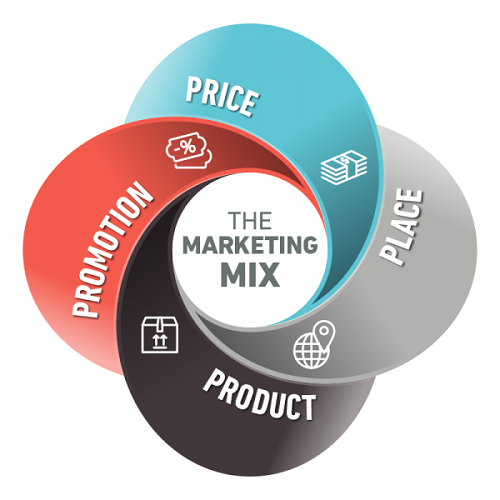The Marketing Mix
Marketing is all about reaching the right consumers at the right place, with the right product/services that can deliver value and satisfaction to them. But this single line explanation does not justify the work that goes behind making a successful marketing campaign.
Specifically, marketeers have to go through extensive research and thinking to answer some important questions even before they start ideating their campaign. Which audience to reach? How to reach them? When and where to reach them? How is your product/service a value for them? All these questions form the foundation on which your strategy stands.
This is where marketing mix comes in. According to Philip Kotler, marketing mix is a broad term that encompasses all the tools and tactics that marketeers use to elicit desired responses from their target market.
To make it simpler, these tools and tactics have been categorized under four groups and called the four P’s of marketing: Product, Price, Place and Promotion. These 4P’s are the pillars for any marketing strategy.
But marketing mix is rooted in deep understanding for you target segment. Marketeers should first understand their consumers using the right consumer insights and build their strategy and campaign around them. How to understand your consumer? That’s a topic of another discussion
Now that we understand our customers, their psychography and demography, its time to make the 4P’s fall in order with your consumer understanding. Let’s delve deeper into the concept of 4P’s of marketing.
Product mix
Product mix is all the products and services that you put in front of your customers for them to buy. Your product and services represent your brand at different point of sales and its your product and services that has the highest influence in your consumer’s mind. It creates an image for your brand.
But the product mix is not about your products and its specifications, rather, It needs to answer the very basic question for your strategy: How is your product a solution for your target audience, or rather, why would they buy your product?
This mix comes into play during the development phase of your product or services. Some things to keep in mind when ideating your product are:
- Why will your target audience use your product?
- How will they use it?
- Where will they use it?
- How will they recognize your product, what would be its name?
- How is your product different from your competitors?
- How does your product feel to your customers? Its look and feel, the colors and packaging etc.
- And Lastly, what emotions will it evoke?
Price
Price is how much the customer pay for your product and services. As you can guess, pricing plays a very important part in determining how well your product will do in the market and how much profit you will make from your product and services. Essentially, it determines the survival of your brand.
Pricing also affects the perceived value of your brand. A low price would usually mean an inferior good and consequently, an inferior brand. On the other hand, an overpriced product will make your customers choose your competition over you. Thus, fixing a price tag on your product is very tricky.
There are four major pricing strategies that are used in various stages of marketing:
- Market penetration pricing: Low pricing to capture a market share. Usually the best strategy for new brands.
- Skimming pricing: Pricing is kept high initially and then lowered subsequently. This increases the perceived value of your product. Usually used by well established brands, Example, Samsung lowering the price of its older models a couple of months before launching the new product. This is also used to create a distinction between your various products in same segment.
- Competition pricing/neutral pricing: Pricing comparable to your competitors
Pricing mix should answer the following questions:
- What is the perceived value of your product?
- What is the profit margin on every sale?
- Justify pricing change. Can it help in gaining significant market share? Can it alter the perceived value of your product?
Place
It helps in determining the placement and distribution of your product. If your product doesn’t reach your intended customer, your campaign is a failure. Thus, placement and distribution are largely dependent on your consumer understanding.
Some business might also use distribution to enhance the perceived value of their products. Selective distribution at limited outlets or placing your products in an elite mall in an upper-class market area can increase the perceived value of your product and enhance the image of your brand.
Businesses can either start from a small geographical area and then expand to other areas or go for a franchise system. There are various placement strategies and it’s a broad topic in itself. But whatever tactics you use, placement mix needs to clear these basic questions:
- Where can your clients look for your product or services
- What kind of outlet will complement the value of your product?
- How your product placement and distribution compare to your competitors? Are their more visible in the market than your products?
Promotion
Promotion mix comes into play after all the above P’s have been finalized. It helps you connect to your consumers. Promotion gives you a chance to directly talk with your customers about your product and distinguish your products from that of your competition. Promotion mix includes various tools such as advertising, PR, sales marketing, events, consumer engagements, word of mouth among others.
Promotion mix heavily depends on your consumer’s daily habits. So, consumer understanding is a must. A good promotion mix should answer the following questions:
- What is your promotion budget?.
- What message do you want to convey? What’s you USP and Button?
- Through what channels will you reach your audience
- How, when and where to reach to your consumer with your messages?
- How is your promotion strategy different from that of your competitors?
These 4P’s cover most of the things a business needs to consider before developing a campaign strategy.









